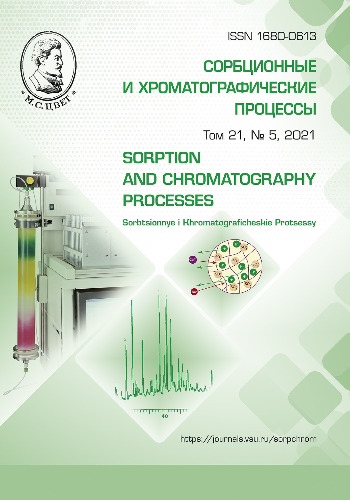Ion-exchange production of pyrophosphoric acid at increased temperatures
Abstract
One of the important areas of inorganic materials science is the development of materials for bone implants based on resorbable inorganic phosphate materials for the regenerative treatment of bone tissue defects. Resorbability means that the inorganic material of the bone implant is gradually recycled by the body, acting as a source of ions for the growth of new bone tissue. Such materials include β-tricalcium phosphate Ca3(PO4)2; calcium pyrophosphate Ca2P2O7; calcium metaphosphate Ca(PO3)2; calcium sodium renanite CaNaPO4, etc. They are more resorbable than hydroxyapatite Ca10(PO4)6(OH)2, which is the main mineral constituent of bone tissue.
In the synthesis of certain resorbable inorganic phosphate materials for the regenerative treatment of bone tissue defects, the use of pure polyphosphoric acids provides significant advantages. These acids are obtained from sodium polyphosphates such as sodium pyrophosphate.
This paper studies the process of pyrophosphoric acid preparation from sodium pyrophosphate by cation exchange on a strongly acidic polystyrene-type cation exchanger at elevated temperatures. The concentration of polyphosphoric acid obtained by the ion exchange method is limited by the solubility of the original sodium polyphosphate. However, the solubility of sodium pyrophosphate typically increases significantly with a temperature increase. This experimental study confirmed the possibility of obtaining much higher concentrations of pyrophosphoric acid by ion-exchange synthesis on sulphonic acid cationite at increased temperatures. The ion-exchange synthesis was carried out in a column with a thermostatic control of the column and the vessel containing the initial feed solution of sodium pyrophosphate. The fronts of the exchange of hydrogen ions for sodium ions are very sharp at all temperatures, thus providing large volumes of pure pyrophosphoric acid without any sodium ion impurities.
Downloads
References
Safronova T.V., Neorganicheskie materialy, 2021, Vol. 57, No 5, pp. 467-499.
Safronova T.V., Kurbatova S.A., Shata-lova T.B., Knot'ko A.V. et al., Materi-alovedenie, 2016, T. 7, No 7, pp. 41-48.
Vulih A.I. Ionoobmennyj sintez. M., Khimiya, 1973, 231 p.
Van Wazer J.R., Holst K.A., J. Am. Chem. Soc., 1950, Vol. 72, No 2, pp. 639-644.
Safronova T.V., Putlyaev V.I., Kurbatova S.A., Shatalova T.B. et al., Neorganiches-kie materialy, 2015, Vol. 51, No 11, pp. 1269-1276.
Watters J.I, Loughran E.D, Lambert S.M., J Am. Chem. Soc., 1956, Vol. 78, No 19, pp. 4855–4858.
Watters J.I, Sturrock P.E., Simonaitis R.E., Inorg. Chem., 1963, Vol. 2, No 49, pp. 765-767.
Lecocq J., J. Med. Chem., 1968, Vol. 11, No 5, pp. 1096-1097.
Safronova T.V., Kiselev A.S., Shatalova T.B., Filippov Ya.Yu. et al., Izvestiya Akad-emii nauk. Seriya himicheskaya, 2020, No 1, pp. 139-147.
Lur'e Yy.Yu. Spravochnik po analit-icheskoj khimii, M., Khimiya, 1979, 480 p.
Fedorov A.A. Chernyahovskaya F.V., Vernidub A.S., Anan'evskaya M.P. et al. Analiticheskaya himiya fosfora, Pod red. A.P. Vinogradova, M., Nauka, 1974, 220 p.
Reichenberg D., McCauley D.J., J. Chem. Soc., 1955, Vol. 3, pp. 2741-2749.







